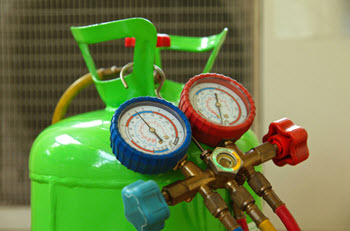Does Your Air Conditioner Use R-22? Here’s What To Consider
 Hot summer days become bearable thanks to the hard work of central air conditioning systems. They keep homes cool inside despite the scorching temperatures outside. Even these reliable appliances have their limits. Those that frequently break down and are over 15 years old may need more than just simple repair. In some cases, it might be better to replace them outright. Another consideration is the R-22 phase-out that was imposed by the US federal government and finalized on January 1, 2020. This means that owners of old A/C units will currently have to pay exorbitant costs for new refrigerant due to this phase-out.
Hot summer days become bearable thanks to the hard work of central air conditioning systems. They keep homes cool inside despite the scorching temperatures outside. Even these reliable appliances have their limits. Those that frequently break down and are over 15 years old may need more than just simple repair. In some cases, it might be better to replace them outright. Another consideration is the R-22 phase-out that was imposed by the US federal government and finalized on January 1, 2020. This means that owners of old A/C units will currently have to pay exorbitant costs for new refrigerant due to this phase-out.
When Will The Total Ban On R-22 Commence In The US?
Table of Contents
- 1 When Will The Total Ban On R-22 Commence In The US?
- 2 Can R22 Still Be Bought In New York Today?
- 3 The Environmental Reason Behind The Fall Of R-22
- 4 A Tale of Two Refrigerants: R22 And R410a Explained
- 5 The High Cost Of R-22 Refrigerant
- 6 The Price Of Getting A New Central A/C With Tax Credits And Other Savings
- 7 Conclusion
Every unit needs a refrigerant to circulate in the system to facilitate heat transfer. R22 used to be the industry standard because of its proven effectiveness in doing this job. Nevertheless, the substance was eventually cast aside when its negative ecological impact became known. Governments all over the world pressured the HVAC industry to look for an alternative while R-22 came under strict regulation. The date for this compound to be a banned substance fell on January 1, 2020. After this date, it was considered illegal to import or make it in the US.
Can R22 Still Be Bought In New York Today?
The finalization of the R22 ban has already taken place. Owners of old air conditioners can still avail of this refrigerant. However, the high prices may put off people from buying it for their air conditioning units. The demand is just so much higher than the supply at this point. Thus, the fundamental laws of economics are pushing the cost upwards. R-22 refrigerant price will only get worse as time moves forward. According to estimates, homeowners may have to shell out $2,000 or more for a recharge. Factor in the decreasing efficiency of older systems and it becomes more attractive to upgrade to a brand new cooling system.
Do not hesitate to call Hart Home Comfort if you would like advice and a free quote for your cooling system.
From the start of 2020, R22 refrigerant will no longer be imported or produced. Existing units that require a recharge will either need to be replaced or face a hefty repair. However, most HVAC experts agree that replacing the whole air conditioning unit is a far more economical choice. The good news is that you can enjoy the low costs of an air conditioner replacement this year.
The Environmental Reason Behind The Fall Of R-22
 Nothing is more important than the protection of the environment. After all, the Earth is our only planet, and any damage we make will come back to haunt us. Unfortunately, R-22 turned out to be a harmful substance that contributed to the destruction of the ozone layer.[1] This aspect is alarming because the ozone acts as a shield against ultraviolet radiation. Without it, the sun’s rays can become extremely dangerous to living beings.
Nothing is more important than the protection of the environment. After all, the Earth is our only planet, and any damage we make will come back to haunt us. Unfortunately, R-22 turned out to be a harmful substance that contributed to the destruction of the ozone layer.[1] This aspect is alarming because the ozone acts as a shield against ultraviolet radiation. Without it, the sun’s rays can become extremely dangerous to living beings.
Since R22 and other ozone-depleting substances [2] fell out of favor, the ozone layer has begun to heal, with the hole decreasing in size year after year. If you would also like to help the environment, then consider retiring your old HVAC system and getting a replacement that uses a more eco-friendly refrigerant such as Puron or R-410a.
A Tale of Two Refrigerants: R22 And R410a Explained
What Are The Differences Between R-22 & R-410a?
The reality is that every machine becomes less efficient over time. HVAC systems are no exception. Dirt will find its way through the openings and into the units. Pipes and containers will develop leaks. Air conditioners can maintain their capacity to cool down a home, but they will need more power to do so. At some point, homeowners may no longer feel their cooling effect at all. A higher bill will accompany the rise in power consumption. Sticking to an old unit will eventually become more expensive than installing a modern energy-efficient system.
The past two decades have seen numerous innovations in cooling technologies. Many of these have focused on improving energy efficiency for the benefit of the environment and the consumers. A direct comparison of models from 15-20 years ago to the most recent ones will reveal a massive jump of efficiency. They will only need to consume a small amount of power to cool a space. The technological superiority of new systems and the natural degradation of old units make replacement a financially viable option.
The High Cost Of R-22 Refrigerant
 If you are really keen on holding on to your existing A/C, then just be aware of the costs that you are likely to encounter. Currently, you should still be able to find a few sources for the R22 refrigerant, but the prices have been creeping up for the past few years. Given the impending ban that occurred at the beginning of 2020, the r-22 refrigerant price increase has accelerated even more with current levels almost being out of reach.
If you are really keen on holding on to your existing A/C, then just be aware of the costs that you are likely to encounter. Currently, you should still be able to find a few sources for the R22 refrigerant, but the prices have been creeping up for the past few years. Given the impending ban that occurred at the beginning of 2020, the r-22 refrigerant price increase has accelerated even more with current levels almost being out of reach.
The problem is that most old systems develop leaks that cause refrigerant to fall below acceptable levels. Cooling systems will not be able to work well unless an HVAC contractor fixes the issue and the refrigerant goes back up the threshold. Sooner or later, current owners will have to deal with these exorbitant prices. Things will get worse as we march forward. Supplies will get even more scarce, and demand will intensify.
The Price Of Getting A New Central A/C With Tax Credits And Other Savings
Governments all over the world are getting rid of ecologically dangerous substances like R22. As part of the US government’s campaign, upgrades are encouraged through perks like tax breaks and rebates. This aspect should help offset the cost of investing in a new air conditioner for your home. You can find more information through the ACCA or Air Conditioning Contractors of America.
The tax breaks and rebates are often dependent on the number called the Seasonal Energy Efficiency Ratio (SEER). As the SEER of a unit goes up, the incentives also go higher. Aside from these, having a high-efficiency air conditioner will naturally mean lower energy consumption and thus reduced monthly payments for the utility companies.
When buying cars, we are conscious of the estimated number of miles that they can go per gallon. SEER functions much the same way: it indicates just how much cooling an A/C can provide per unit energy. For instance, it is better to get a model with 27 SEER than one with a 15 SEER rating. Today’s best air conditioners use 30% to 50% less energy to produce the same amount of cooling as air conditioners made in the mid-1970s. Even if your air conditioner is only 10 years old, you may save 20% to 40% of your cooling energy costs by replacing it with a newer, more efficient model.[3]
If you would like to know more details about the tax breaks in your region, then give Hart Home Comfort a call. We will be more than happy to share pertinent information so that you can make the best decision. Call us at (631) 667-3200 today!
Conclusion
Hart Home Comfort is a trusted name when it comes to heating and cooling. Our clients span both commercial and residential properties. We can provide high-quality HVAC installations, repairs, maintenance, and tune-ups whenever needed. All these are available at reasonable rates. Our experienced team will extend professional service that you can count on every single time. Don’t hesitate to contact us if you have any questions. You can always avail of a free consultation with our HVAC experts. Call us today!
For any questions about what Hart Home Comfort can do for you, give us a call today. Click here to contact us now or call us at (631) 667-3200 to find out more!
[1] Phaseout of Ozone-Depleting Substances (ODS) (https://www.epa.gov/ods-phaseout)
[2] Ozone depletion, explained (https://www.nationalgeographic.com/environment/global-warming/ozone-depletion/)
[3] US Department of Energy (https://www.energy.gov/energysaver/central-air-conditioning)
